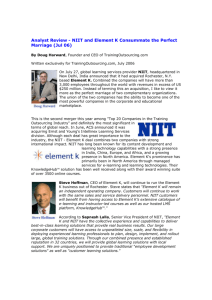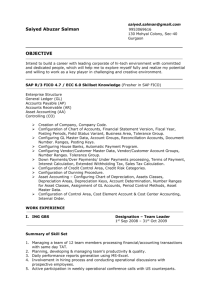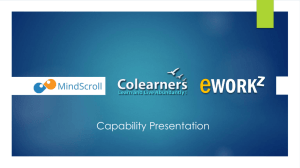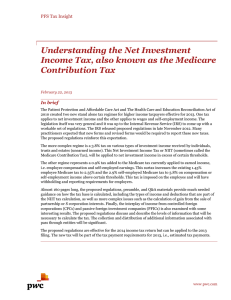Life Insurance: Closed Book of Business
advertisement
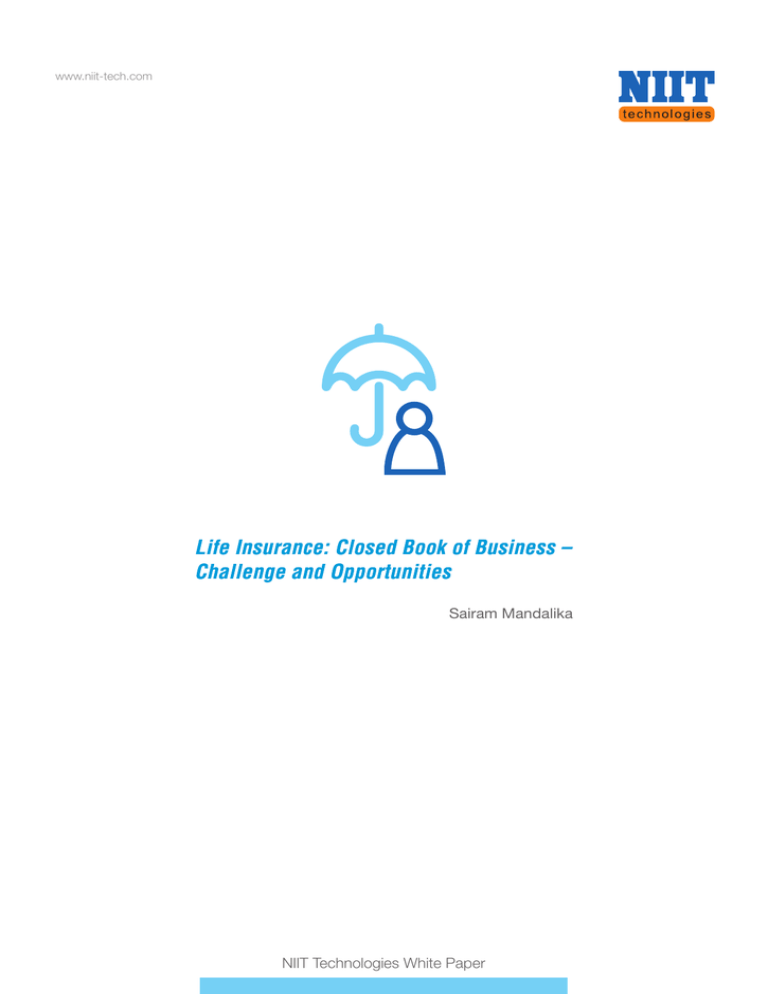
www.niit-tech.com Life Insurance: Closed Book of Business – Challenge and Opportunities Sairam Mandalika NIIT Technologies White Paper CONTENTS Introduction 3 Problem Statement 3 Key Challenges of Closed Book 3 Traditional Approaches 3 The Solution 4 Benefits 5 Summary 5 References 5 About the Author 6 About NIIT 6 Introduction 1. Maintaining Legacy Systems In the wake of increased competitio n and dynamic economic environment, the insuranc e industry today faces the daunting Closed funds are usually maintaine d on old Legacy Policy Administration Systems which have very high maintenance costs challenge of maintaining operational efficiency. 2. Operational Cost Management Closed books are policies that are no longer sold but are still on the books of a life insurance carrier as premium-paying policies. Closed books are caused by either discontinuin g unprofitable products or as a result of acquisitions and mergers. The hardware As no new policies are sold, the portfolio size steadily decreases over time. Steadily decreasing portfolio size demands parallel reduction in policy administration costs to keep the business profitable. and application maintenance costs for the legacy systems that run 3. Regulatory Penalties the closed books are high. The workings of a closed book is likely to be scrutinized by Insuranc e carrier s are looking for cost savings , operationa l regulators and capital markets efficiencie s and ways to get closer to their customers . This whitepape r evaluate s variou s solution s for cost-e ffectiv e management of closed books for global life insurance carriers. 4. Deteriorating Customer Service Due to inter-play of factors like transition management and bad publicity, customer service may suffer in a closed book. Problem Statement 5. Staff and Agent Attrition Most vendor product applications are derived from IBMs’62 CFO As portfoli o size decreases in closed books business , any product - for example Vantage-one, Cyberlife, LifeComm, LIDP, unexpected surrenders or terminations can prove disastrous. Life/70, and Life400.Thes e application s are also derived from homegrown products that are modeled on IBM’s products. They are in third generatio n language s like COBOL/Assemble r on Mainframe . Product companie s also introduce their own complexit y to ensure continue d dependenc y of insuranc e companies on their applications. Client s in closed books busines s may not have any advisor/agent for on-going advice or service. Traditional Approaches Outsource Closed Book Administratio n to a Third Party Key Challenges of Closed Book Companies hire high-end resources for providing certain services In-house management of closed book operations presents many that cannot be met by the internal staff. They utilize these obstacle s for businesse s looking for agility in an increasingly resources on need basis and get the critical work accomplished competitive environment. These challenges touch most areas of the instead of spendin g time on upgradin g the existin g team’s business, making it harder to reduce operational costs, complicating knowledge. This model works during introduction of new products financial reporting, and obstructing new selling opportunities. but in the closed block scenario, this is expensive as there is no 3 return on investment. In addition to costs, the existing team does This per contract cost is high in the long run. Though there is not gain any knowledge out of this engagement. minimal or no activity on many contracts, insurance companies have to bear the support cost. Dual Shore Support Model Most insurance companies moved from outsourcing support to high cost product companies to the dual shore support model. In The Solution this model, the cost gets reduced as the offshore team provides Obtain a Vendor Product support. With this model, insurance companies continue to have Since all insurance products are based on IBMs’ 62 CFO, obtaining control on day-to-day operations. Though this model gives benefits license for any one of these products (NTL-INSURE) is one solution. every year, it has its own set of challenges. As these are closed blocks of business, any of the earlier versions of • Continued increasing operational costs Infrastructure - Hardware - License costs - Several tools - Connectivity Management - Added layers of management (Internal/Vendor) - Retention of high end resources (BAs/SMEs) Utilizing Third Party Administrators (TPAs) In this approach, the entire support of the product is moved to a TPA. TPA administer s the contract s on his infrastructu re and provides feeds to the internal system s for reportin g and compliance. This eliminates the redundancy of dual management layers and reduces infrastructure costs too. The TPA approach creates more expenses in the customer contact areas like BPO etc. as resources need to be trained on TPA applications . To circumvent this, insuranc e companie s try to outsource even the BPO operations to TPA. This may not always work, as many of the TPAs do not have custome r contact application support in their solutions. In addition, there is also a one-time major cost of converting to a TPA system. It comes with the risk of reconversion cost, if the insurance company decides to break away from the TPA. TPAs have home grown application s that are proprietar y, and reconverting back to the insurance company’s products is a major effort. Moreover, as TPA’s products are in-house , it becomes mandatory to use only TPA’s resources for reconversion. Insurance companies are forced to continue till the end of all contracts, as the product will serve the purpose, thereby reducing licensing costs. In addition, the changes required for administering the system’s product features is minimal. This is because most of these products that have been a part of the closed block of business and would have been issued a long time ago. They have similar type of benefits and riders across multiple insurers. Most of the older versions of the vendor products have almost all features and little or no changes are required for the product specific feature. Most of packages have company based processing logic that can be leveraged for setting up different businesses under the same insurance company and for multiple insurance companies. It is best to get NTL-INSURE application converted to Linux platform which requires less operational cost. Expertise in NTL-INSURE product administration must be built by acquiring Subject Matter Experts (SMEs) and Business Analysts (BAs). By utilizing their expertise and NIIT MATRIX methodology learning plans and certifications specific to the application can be built. It helps ramp up of resources easily. A non-intrusive conversion approach has to be defined. In this approach reusable components have to be built to perform conversion from any source system. The design is such that a common set of information is obtained from the source system, irrespective of whether it is a vendor product or home grown product. This is then converted into NTL-INSURE by reusable conversion component. These tools ensure that the information in the system is returned back to insurance companies for further reconversion in case of contract terminations. It saves on conversion costs and eliminates the dependency of insurance company on NIIT Technologies for reconversion purposes. they find it difficult to move out of TPA contracts. 4 An end-to-end cost based contract service rather than current per Reduced Operational Costs contract charges must be provided. This ensures the elimination of When closed block of business is being administered by unnecessary costs incurred for contracts that have had no activity in NTL-INSURE, insurance Companies can easily implement changes a given period. in their existing systems with less impact and cost. Benefits Summary Minimal Conversion Cost Closed book of business is a major issue in insurance industry Conversion cost is minimal for the insurance company when they where contracts are serviced for very long terms. These contracts map to the business layout provided by NIIT Technologies. Very little need support till the last contract in the book is active. Owing to the effort is needed from insurance company. complexity and multiplicity of vendor product systems, acquisitions, Smoother Transition Conversion to and from NTL-INSURE is relatively smoother as it involves little or no external resources. Faster Response Time As these contracts are administered on other platforms, the response times are much faster than on legacy platforms. In addition NIIT Technologies Smartserve’s best practices ensure continuous improvements. and several touch points, administering becomes expensive. The current model of getting high-end work done through contractors, outsourced dual-shore support or employing a TPA for support are not proving to be cost effective solutions. The NTL-INSURE solution caters to this problem effectively. It ensures that the insurance company gets the required support at a very little cost. At the same time, the company will have the flexibility of reconverting the contracts at minimal cost. Reduced Maintenance Cost As insurance companies pay according to services rendered, rather than per contract basis, there is a lot of cost reduction. Improved Customer Services Being CMMi Level-5 entities, NIIT Technologies and NIIT Technologies Smartserve provide superior customer services. 24X7 Services Having offshore infrastructure support and by providing dual-shore or near shore operations, there can be extended hours of customer support resulting in increased customer satisfaction. 5 About the Author Sairam Mandalika is Delivery Head Insurance practice at NIIT Technologies. He has done fellowship in Insurance, LOMA-Level-1, ITSM, PMP, and is a certified Actuary. Sairam has over 28 years of experience in the Insurance domain – Life, Annuity, P&C, Multiple Insurance vendor policy administration products. He was instrumental in designing and implementing solutions for all the Life Insurance operations. About NIIT Technologies NIIT Technologies is a leading IT solutions organization, servicing customers in North America, Europe, Asia and Australia. It offers services in Application Development and Maintenance, Enterpris e Solution s includin g Managed Service s and Busines s Process Outsourcing to organisations in the Financial Services, Travel & Transportation, Manufacturing/Distribution, and Government sectors. With employees over 7,000 professionals, NIIT Technologies follows global standards of software development processes. Over the years the Company has forged extremely rewarding relationships with global majors, a India testimony to mutual commitment and its ability to retain marquee clients, drawing repeat NIIT Technologies Ltd. Corporate Heights (Tapasya) Plot No. 5, EFGH, Sector 126 Noida-Greater Noida Expressway Noida – 201301, U.P., India Ph: + 91 120 7119100 Fax: + 91 120 7119150 business from them. NIIT Technologies has been able to scale its interactions with marquee clients in the BFSI sector, the Travel Transport & Logistics and Manufacturing & Distribution, into extremely meaningful, multi-year "collaborations. NIIT Technologies follows global standards of development, which include ISO 9001:2000 Americas Certification, assessment at Level 5 for SEI-CMMi version 1.2 and ISO 27001 information NIIT Technologies Inc., 1050 Crown Pointe Parkway 5th Floor, Atlanta, GA 30338, USA Ph: +1 770 551 9494 Toll Free: +1 888 454 NIIT Fax: +1 770 551 9229 security management certification. Its data centre operations are assessed at the international ISO 20000IT management standards. Europe NIIT Technologies Limited 2nd Floor, 47 Mark Lane London - EC3R 7QQ, U.K. Ph: +44 20 70020700 Fax: +44 20 70020701 Singapore NIIT Technologies Pte. Limited 31 Kaki Bukit Road 3 #05-13 Techlink Singapore 417818 Ph: +65 68488300 Fax: +65 68488322 Write to us at marketing@niit-tech.com www.niit-tech.com D_06_120413 A leading IT solutions organization | 21 locations and 16 countries | 8000 professionals | Level 5 of SEI-CMMi, ver1.2 ISO 27001 certified | Level 5 of People CMM Framework
